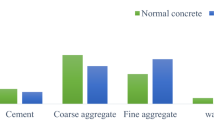Conclusions
1. The high effectiveness of roller compacted concrete technology is proved by its wide use in world practice. In the world there are presently more than 160 dams more than 15-m high constructed by this technology. One of the reasons for the effectiveness of RCC is the use of various types of pozzolana additives to the cement clinker, which is confirmed by the experience of constructing more than 90% of the dams constructed.
2. Along with traditional pozzolana additives obtained from tripoli, diatomite, etc., fly ash and in its absence socalled rock flour, obtained at the construction site by crushing hard and soft rocks, have gained wide use. In this case it is important to study such an artificial pozzolana additive for a temporal change in its activity with respect to binding calcium hydroxide. The results of studies should be reflected in the technological requirements imposed on works with RCC.
3. On the basis of the data on the properties of RCC obtained in experiments, it can be concluded that there is no fundamental difference between ordinary and roller compacted concrete except that which is due to the presence in RCC of an increased number of contacts between concrete layers. Therefore, it is vitally important to study the properties of these contacts, which is confirmed by the large number of studies of the behavior of horizontal block joints carried out in the past decade for dams being planned and under construction.
Similar content being viewed by others
References
J. Diez-Gascon, Theme 1 "Materials" General Reporter (Spain), Proceedings of the International Symposium "Roller Compacted Concrete Dams, Santander, Spain, October 2–4, 1995, Vol. 3.
M. Dustan, Theme 2 "Planning and design" General Reporter (UK), ibid.
F. R. Andriolo, "RCC properties," in: Proceedings of the International Symposium "Roller Compacted Concrete Dams," Santander, Spain, Vol. 1, October 2–4, 1995.
A. F. Krempel and F. R. Andriolo, "High paste content and low cement content mixes, finely crushed rock, specific gravity, compacted ratio, low cost…. Discussions and values obtained," ibid.
A. F. Krempel, C. C. Crevilara, and F. G. Holanda, "Jordao river derivation dam. Study of RCC mixes design with low cement content," ibid.
A. F. Krempel and F. R. Andriolo, "The use of basaltic crushed powder filler in the RCC," ibid.
P. J. Oliveira, F. M. Salles, and F. R. Andriolo, "Crushed powder filler for use on RCC and the reduction of expansion due to the alkali-aggregate reaction," ibid.
P. J. Oliveira, F. M. Salles, and F. R. Andriolo, "Studies of various types of RCC mix design. Laboratory test results," ibid.
Zeng Li and Fang Kuhne, "The setting state of RCC and the control of binding quality between layers," ibid.
Zhou Shouxian, Yang Huaguan, and Kuang Vali, "Properties of low portland cement clinker content RCC," ibid.
M. Ho Ta Khanh, F. Delorme and R. Valon, "RCC laboratory tests: experience acquired in the past ten years and new developments," ibid.
E. A. Kogan and V. E. Fedossov, "Roller compacted concrete and horizontal construction joint strength," ibid.
J. Hess, "Design and materials for Auburn dam," ibid.
Additional information
Translated from Gidrotekhnicheskoe Stroitel’stvo, No. 4, pp. 5–12, April, 1998.
Rights and permissions
About this article
Cite this article
Fedosov, V.E., Kogan, E.A. & Osipov, A.D. Materials for roller compacted concrete used in modern dam construction. Hydrotechnical Construction 32, 181–188 (1998). https://doi.org/10.1007/BF02918723
Issue Date:
DOI: https://doi.org/10.1007/BF02918723




